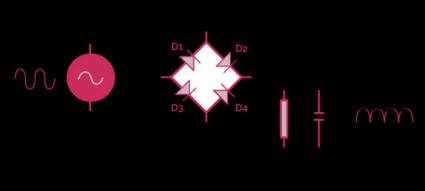Bridge Rectifier Calculator
This bridge rectifier calculator can assist you in understanding how a bridge rectifier circuit works and how to use one.
Bridge rectifiers convert the AC (alternating current) supply voltage to a DC (direct current) supply voltage using four diodes that are ingeniously positioned. Regardless of the polarities of the input AC signal, the output signal of such a circuit always has the same polarity. You can use this tool to calculate the output DC voltage, current, RMS current, and ripple factor of the rectification. And if you want to learn more about what is a bridge rectifier and its usage in everyday life, keep reading!
You can also delve into other electromagnetism circuits with our wheatstone bridge calculator or learn more about laws that govern electromagnetism with Omni's Faraday's law calculator and Coulomb's law calculator.
What is a full-wave bridge rectifier?
The bridge rectifier, or a full-wave bridge rectifier, is made up of four separate p-n junction diodes, an alternating supply, and a load resistor. Bridge rectifiers or diode bridge rectifiers have four diodes that create a closed loop, referred to as a bridge. The fundamental benefit of the bridge rectifier circuit is that it does not require a central tape transformer, which decreases its size.
The input of one side of the bridge is connected to the single winding. The load resistor is on the other side of the bridge, as shown in the bridge rectifier diagram below:

Let's observe how an AC signal affects this rectifier circuit using the bridge rectifier diagram:
1. The diodes D2 and D3 are forward biased and begin to conduct during the first positive half cycle of the AC signal, and the diodes D1 and D4 are forward biased during the negative half cycle of the AC signal. Alternatively, the pairs of diodes are reverse-biased and will not conduct at the same time.
2. Through the two forward-biased diodes, current will flow through the load resistor. The positive voltage at terminal d and negative voltage at terminal c will be detected at the output. Similarly, at terminals a and b.
3. As a result, the output polarity will always be the same, regardless of the polarity of the input signal. We can also argue that the AC signal's negative half-cycle has been reversed, resulting in a positive voltage at the output.
Since this single polarity output voltage is pulsing and not a straight line in nature, it is not pure DC voltage. As indicated in the full-bridge rectifier diagram below, this problem is simply handled by connecting a capacitor in parallel with the load resistor.

When the voltage is increasing, the capacitor is charged via the diodes D2 and D3 in this new configuration of the bridge rectifier circuit. The capacitor will cease charging and begin to discharge itself through the load resistor after the voltage peaks and starts to go back down again.
Here is how you can use this full bridge rectifier calculator
This bridge rectifier calculator can estimate four parameters of the rectification.
If you select...
1. DC voltage (VDC) option:

Just input the peak AC voltage (), and the calculator computes the DC voltage () for you. If you would like to calculate it on your own, you can use the formula below:
2. Current option:
Let us use the term to designate the voltage coming from the secondary windings of the transformer (or input voltage):
Using Ohm’s law to derive the current, we should note that two types of resistance will limit the current, the load resistance (RL), and the forward resistance of the diode (Rf).
Note: We can find the forward resistance using the diode’s I-V characteristic.
The current option asks you to enter the following:
- Enter the load resistance .
- Enter the forward resistance of the diodes .
- Input the maximum AC voltage .
And this calculator computes the current using the equation below:
3. RMS current option:
This bridge rectifier calculator computes the RMS (root mean square) current () from as shown below:
4. Ripple factor option:
It computes the ripple factor of the output waveform as the ratio of the ripple current (also known as the RMS current) to the DC current.
If you enter RMS current (I_RMS) and the DC current (I_DC), this calculator gives you the ripple factor.
Applications of a bridge rectifier circuit
- Bridge rectifiers are extensively utilized in power supply circuits due to their low cost compared to center-tapped circuits.
- The amplitude of modulated radio waves can be detected using a bridge rectifier circuit.
- They can also be used in welding to provide polarized voltage.
What can I use a bridge rectifier for?
A bridge rectifier converts alternating current (AC) input to direct current (DC) output. In electronic power supplies, a bridge rectifier circuit is a typical component. Many electronic circuits necessitate using a rectified DC power source to power the numerous electronic fundamental components from an AC mains supply.
How can I test a bridge rectifier?
A bridge rectifier is made up of four diodes, and it is tested in the same way as a diode. Because of the way it's constructed, you can test each diode separately, and the other diodes are placed such that they won't interfere with your reading. Each diode should have around a 0.7 V drop in one direction and no flow in the other.
How can I use a bridge rectifier?
A bridge rectifier can be used to convert an alternating-current (AC) input to a direct-current (DC) output. A diode bridge rectifier is a bridge circuit layout that uses four diodes to generate the same polarity of output for either polarity of input.
How do I calculate the ripple factor of a bridge rectifier?
To calculate the ripple factor of a bridge rectifier:
- Take the ratio of RMS current to the pure DC current.
- Most of the bridge rectifiers have a ripple factor of 0.48.
